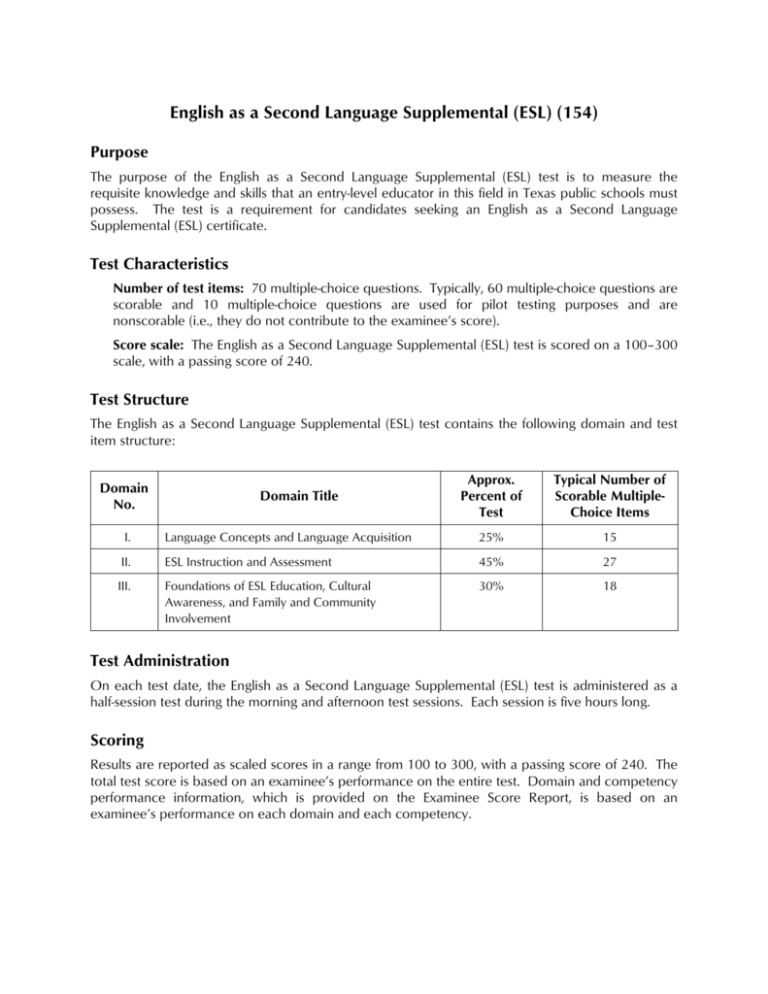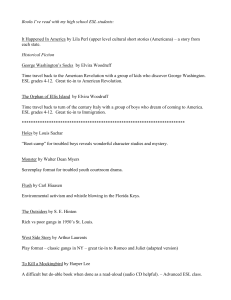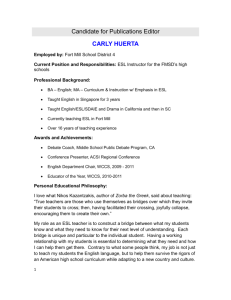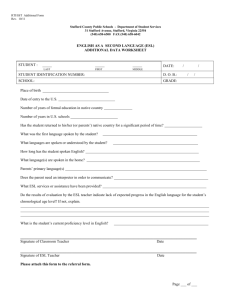
English as a Second Language Supplemental (ESL) (154)
Purpose
The purpose of the English as a Second Language Supplemental (ESL) test is to measure the
requisite knowledge and skills that an entry-level educator in this field in Texas public schools must
possess. The test is a requirement for candidates seeking an English as a Second Language
Supplemental (ESL) certificate.
Test Characteristics
Number of test items: 70 multiple-choice questions. Typically, 60 multiple-choice questions are
scorable and 10 multiple-choice questions are used for pilot testing purposes and are
nonscorable (i.e., they do not contribute to the examinee’s score).
Score scale: The English as a Second Language Supplemental (ESL) test is scored on a 100–300
scale, with a passing score of 240.
Test Structure
The English as a Second Language Supplemental (ESL) test contains the following domain and test
item structure:
Domain
No.
Domain Title
Approx.
Percent of
Test
Typical Number of
Scorable MultipleChoice Items
I.
Language Concepts and Language Acquisition
25%
15
II.
ESL Instruction and Assessment
45%
27
III.
Foundations of ESL Education, Cultural
Awareness, and Family and Community
Involvement
30%
18
Test Administration
On each test date, the English as a Second Language Supplemental (ESL) test is administered as a
half-session test during the morning and afternoon test sessions. Each session is five hours long.
Scoring
Results are reported as scaled scores in a range from 100 to 300, with a passing score of 240. The
total test score is based on an examinee’s performance on the entire test. Domain and competency
performance information, which is provided on the Examinee Score Report, is based on an
examinee’s performance on each domain and each competency.
Please note:
•
Domain and competency performance information presents the number of questions
answered correctly out of the total number of scorable questions appearing on the test.
•
Domain and competency performance information is included to help assess an examinee’s
areas of relative strength and need.
•
Domain and competency performance information may be based on comparatively few test
questions and may be less reliable than total test information.
Test Framework
The complete test framework for this field, containing the competencies and descriptive statements
for each domain, appears on the following pages.
Score Report Instructions
A section of the Examinee Score Report entitled “How to Read Your TExES Score Report” appears
on the page following the test framework.
Preparation Manual
The preparation manual for this field may be viewed or downloaded from the TExES Web site at
http://www.texes.ets.org.
Copyright © 2006 by the Texas Education Agency (TEA). All rights reserved. The Texas
Education Agency logo and TEA are registered trademarks of the Texas Education Agency.
Texas Examinations of Educator Standards, TExES, and the TExES logo are trademarks of the
Texas Education Agency.
This publication has been produced for the Texas Education Agency (TEA) by ETS. ETS is under
contract to the Texas Education Agency to administer the Texas Examinations of Educator
Standards (TExES) program and the Examination for the Certification of Educators in Texas
(ExCET) program. The TExES and ExCET programs are administered under the authority of the
Texas Education Agency; regulations and standards governing the program are subject to
change at the discretion of the Texas Education Agency. The Texas Education Agency and ETS
do not discriminate on the basis of race, color, national origin, sex, religion, age, or disability in
the administration of the testing program or the provision of related services.
TEST FRAMEWORK
TExES
Texas Examinations of Educator Standards
Field 154: English as a Second Language Supplemental (ESL)
Test Framework
Domain
Range of
Competencies
I.
Language Concepts and Language Acquisition
001–002
II.
ESL Instruction and Assessment
003–007
III.
Foundations of ESL Education, Cultural Awareness, and
Family and Community Involvement
008–010
This document may not be reproduced for commercial use but may be copied for educational purposes.
TEST FRAMEWORK FOR FIELD 154:
ENGLISH AS A SECOND LANGUAGE SUPPLEMENTAL (ESL)
Domain I
Language Concepts and Language Acquisition
(approximately 25% of the test)
Standards Assessed:
English as a Second Language Standard I:
The ESL teacher understands fundamental language concepts and knows the
structure and conventions of the English language.
English as a Second Language Standard III:
The ESL teacher understands the processes of first- and second-language acquisition
and uses this knowledge to promote students’ language development in English.
Domain II
ESL Instruction and Assessment
(approximately 45% of the test)
Standards Assessed:
English as a Second Language Standard I:
The ESL teacher understands fundamental language concepts and knows the
structure and conventions of the English language.
English as a Second Language Standard III:
The ESL teacher understands the processes of first- and second-language acquisition
and uses this knowledge to promote students’ language development in English.
English as a Second Language Standard IV:
The ESL teacher understands ESL teaching methods and uses this knowledge to plan
and implement effective, developmentally appropriate ESL instruction.
English as a Second Language Standard V:
The ESL teacher has knowledge of the factors that affect ESL students’ learning of
academic content, language, and culture.
English as a Second Language Standard VI:
The ESL teacher understands formal and informal assessment procedures and
instruments (language proficiency and academic achievement) used in ESL programs
and uses assessment results to plan and adapt instruction.
Domain III
Foundations of ESL Education, Cultural Awareness, and Family and Community
Involvement
(approximately 30% of the test)
Standards Assessed:
English as a Second Language Standard II:
The ESL teacher has knowledge of the foundations of ESL education and factors that
contribute to an effective multicultural and multilingual learning environment.
English as a Second Language Standard VII:
The ESL teacher knows how to serve as an advocate for ESL students and facilitate
family and community involvement in their education.
This document may not be reproduced for commercial use but may be copied for educational purposes.
TExES
Texas Examinations of Educator Standards
Field 154: English as a Second Language Supplemental (ESL)
Test Framework
DOMAIN I—LANGUAGE CONCEPTS AND LANGUAGE ACQUISITION
Competency 001
The ESL teacher understands fundamental language concepts and knows the
structure and conventions of the English language.
The beginning ESL teacher:
•
Understands the nature of language and basic concepts of language systems
(e.g., phonology, morphology, syntax, lexicon, semantics, discourse, pragmatics)
and uses this understanding to facilitate student learning in the ESL classroom.
•
Knows the functions and registers of language (e.g., social versus academic
language) in English and uses this knowledge to develop and modify instructional
materials, deliver instruction, and promote ESL students' English language
proficiency.
•
Understands the interrelatedness of listening, speaking, reading, and writing and
uses this understanding to develop ESL students' English language proficiency.
•
Knows the structure of the English language (e.g., word formation, grammar,
sentence structure) and the patterns and conventions of written and spoken
English and uses this knowledge to model and provide instruction in English.
Competency 002
The ESL teacher understands the processes of first-language (L1) and secondlanguage (L2) acquisition and the interrelatedness of L1 and L2 development.
The beginning ESL teacher:
•
Knows theories, concepts, and research related to L1 and L2 acquisition.
•
Uses knowledge of theories, concepts, and research related to L1 and L2
acquisition to select effective, appropriate methods and strategies for promoting
students' English language development at various stages.
•
Knows cognitive processes (e.g., memorization, categorization, generalization,
metacognition) involved in synthesizing and internalizing language rules for
second-language acquisition.
•
Analyzes the interrelatedness of first- and second-language acquisition and ways
in which L1 may affect development of L2.
•
Knows common difficulties (e.g., idiomatic expressions; L1 interference in syntax,
phonology, and morphology) experienced by ESL students in learning English
and effective strategies for helping students overcome those difficulties.
This document may not be reproduced for commercial use but may be copied for educational purposes.
DOMAIN II—ESL INSTRUCTION AND ASSESSMENT
Competency 003
The ESL teacher understands ESL teaching methods and uses this knowledge to plan
and implement effective, developmentally appropriate instruction.
The beginning ESL teacher:
•
Knows applicable Texas Essential Knowledge and Skills (TEKS), especially the
English Language Arts and Reading curriculum as it relates to ESL, and knows
how to design and implement appropriate instruction to address the TEKS
(i.e., listening, speaking, reading, writing, viewing/representing).
•
Knows effective instructional methods and techniques for the ESL classroom,
and selects and uses instructional methods, resources, and materials appropriate
for addressing specified instructional goals and promoting learning in students
with diverse characteristics and needs.
•
Applies knowledge of effective practices, resources, and materials for providing
content-based ESL instruction, engaging students in critical thinking, and
fostering students' communicative competence.
•
Knows how to integrate technological tools and resources into the instructional
process to facilitate and enhance student learning.
•
Applies effective classroom management and teaching strategies for a variety of
ESL environments and situations.
This document may not be reproduced for commercial use but may be copied for educational purposes.
Competency 004
The ESL teacher understands how to promote students' communicative language
development in English.
The beginning ESL teacher:
•
Knows applicable Texas Essential Knowledge and Skills (TEKS), especially the
English Language Arts and Reading curriculum as it relates to ESL, and knows
how to design and implement appropriate instruction to address TEKS related to
the listening and speaking strands.
•
Understands the role of the linguistic environment and conversational support in
second-language development, and uses this knowledge to provide a rich,
comprehensible language environment with supported opportunities for
communication in English.
•
Applies knowledge of practices, resources, and materials that are effective in
promoting students' communicative competence in English.
•
Understands the interrelatedness of listening, speaking, reading, and writing
and uses this knowledge to select and use effective strategies for developing
students' oral language proficiency in English.
•
Applies knowledge of effective strategies for helping ESL students transfer
language skills from L1 to L2.
•
Applies knowledge of individual differences (e.g., developmental characteristics,
cultural and language background, academic strengths, learning styles) to select
instructional strategies and resources that facilitate communicative language
development.
•
Knows how to provide appropriate feedback in response to students' developing
English language skills.
This document may not be reproduced for commercial use but may be copied for educational purposes.
Competency 005
The ESL teacher understands how to promote students' literacy development in
English.
The beginning ESL teacher:
•
Knows applicable Texas Essential Knowledge and Skills (TEKS), especially the
English Language Arts and Reading curriculum as it relates to ESL, and knows
how to design and implement appropriate instruction to address TEKS related to
the reading and writing strands.
•
Understands the interrelatedness of listening, speaking, reading, and writing and
uses this knowledge to select and use effective strategies for developing
students' literacy in English.
•
Understands that English is an alphabetic language and applies effective
strategies for developing ESL students' phonological knowledge and skills
(e.g., phonemic awareness skills, knowledge of English letter-sound
associations, knowledge of common English phonograms) and sight-word
vocabularies (e.g., phonetically irregular words, high-frequency words).
•
Knows factors that affect ESL students' reading comprehension (e.g., vocabulary, text structures, cultural references) and applies effective strategies for
facilitating ESL students' reading comprehension in English.
•
Applies knowledge of effective strategies for helping students transfer literacy
knowledge and skills from L1 to L2.
•
Applies knowledge of individual differences (e.g., developmental characteristics,
cultural and language background, academic strengths, learning styles) to select
instructional strategies and resources that facilitate ESL students' literacy
development.
•
Knows personal factors that affect ESL students' English literacy development
(e.g., interrupted schooling, literacy status in the primary language, prior literacy
experiences) and applies effective strategies for addressing those factors.
This document may not be reproduced for commercial use but may be copied for educational purposes.
Competency 006
The ESL teacher understands how to promote students' content-area learning,
academic-language development, and achievement across the curriculum.
The beginning ESL teacher:
•
Applies knowledge of effective practices, resources, and materials for providing
content-based ESL instruction; engaging students in critical thinking; and
developing students' cognitive-academic language proficiency.
•
Knows instructional delivery practices that are effective in facilitating ESL
students' comprehension in content-area classes (e.g., preteaching key
vocabulary; helping students apply familiar concepts from their cultural
backgrounds and prior experiences to new learning; using hands-on and other
experiential learning strategies; using realia, media, and other visual supports to
introduce and/or reinforce concepts).
•
Applies knowledge of individual differences (e.g., developmental characteristics,
cultural and language background, academic strengths, learning styles) to select
instructional strategies and resources that facilitate ESL students' cognitiveacademic language development and content-area learning.
•
Knows personal factors that affect ESL students' content-area learning
(e.g., prior learning experiences, familiarity with specialized language and
vocabulary, familiarity with the structure and uses of textbooks and other print
resources) and applies effective strategies for addressing those factors.
Competency 007
The ESL teacher understands formal and informal assessment procedures and
instruments used in ESL programs and uses assessment results to plan and adapt
instruction.
The beginning ESL teacher:
•
Knows basic concepts, issues, and practices related to test design, development,
and interpretation and uses this knowledge to select, adapt, and develop
assessments for different purposes in the ESL program (e.g., diagnosis, program
evaluation, proficiency).
•
Applies knowledge of formal and informal assessments used in the ESL
classroom and knows their characteristics, uses, and limitations.
•
Knows standardized tests commonly used in ESL programs in Texas and knows
how to interpret their results.
•
Knows state-mandated LEP policies, including the role of the LPAC, and
procedures for implementing LPAC recommendations for LEP identification,
placement, and exit.
•
Understands relationships among state-mandated standards, instruction, and
assessment in the ESL classroom.
•
Knows how to use ongoing assessment to plan and adjust instruction that
addresses individual student needs and enables ESL students to achieve
learning goals.
This document may not be reproduced for commercial use but may be copied for educational purposes.
DOMAIN III—FOUNDATIONS OF ESL EDUCATION, CULTURAL AWARENESS, AND FAMILY
AND COMMUNITY INVOLVEMENT
Competency 008
The ESL teacher understands the foundations of ESL education and types of ESL
programs.
The beginning ESL teacher:
•
Knows the historical, theoretical, and policy foundations of ESL education and
uses this knowledge to plan, implement, and advocate for effective ESL
programs.
•
Knows types of ESL programs (e.g., self-contained, pull-out, newcomer centers,
dual language, immersion), their characteristics, their goals, and research
findings on their effectiveness.
•
Applies knowledge of the various types of ESL programs to make appropriate
instructional and management decisions.
•
Applies knowledge of research findings related to ESL education, including
research on instructional and management practices in ESL programs, to assist
in planning and implementing effective ESL programs.
Competency 009
The ESL teacher understands factors that affect ESL students' learning and
implements strategies for creating an effective multicultural and multilingual learning
environment.
The beginning ESL teacher:
•
Understands cultural and linguistic diversity in the ESL classroom and other
factors that may affect students' learning of academic content, language, and
culture (e.g., age, developmental characteristics, academic strengths and needs,
preferred learning styles, personality, sociocultural factors, home environment,
attitude, exceptionalities).
•
Knows how to create an effective multicultural and multilingual learning
environment that addresses the affective, linguistic, and cognitive needs of ESL
students and facilitates students' learning and language acquisition.
•
Knows factors that contribute to cultural bias (e.g., stereotyping, prejudice,
ethnocentrism) and knows how to create a culturally responsive learning
environment.
•
Demonstrates sensitivity to students' diverse cultural and socioeconomic
backgrounds and shows respect for language differences.
•
Applies strategies for creating among students an awareness of and respect for
linguistic and cultural diversity.
This document may not be reproduced for commercial use but may be copied for educational purposes.
Competency 010
The ESL teacher knows how to serve as an advocate for ESL students and facilitate
family and community involvement in their education.
The beginning ESL teacher:
•
Applies knowledge of effective strategies advocating educational and social
equity for ESL students (e.g., participating in LPAC and ARD meetings, serving
on SBDM committees, serving as a resource for teachers).
•
Understands the importance of family involvement in the education of ESL
students and knows how to facilitate parent/guardian participation in their
children's education and school activities.
•
Applies skills for communicating and collaborating effectively with the
parents/guardians of ESL students in a variety of educational contexts.
•
Knows how community members and resources can positively affect student
learning in the ESL program and is able to access community resources to
enhance the education of ESL students.
This document may not be reproduced for commercial use but may be copied for educational purposes.
HOW TO READ YOUR TExES SCORE REPORT
Your score report has three sections: 1) Total Test Performance, 2) Performance by Domain, and 3) Performance by
Competency. These results have been forwarded to the TEA and State Board for Educator Certification (SBEC) and,
based on the information you provided, to your recommending Texas educator preparation program (college,
university, or alternative certification program). Scores for one test are reported on each score report. Keep all score
reports for your records. Once you've passed your required tests, you must apply for certification - please see last
section for details on how to apply.
TOTAL TEST PERFORMANCE
Your total scaled score shows how you performed on the test as a whole and whether you passed the test.
For TExMAT and TExES the score range is 100 to 300 with a minimum passing score of 240. For ExCET,
the score range is 1 to 100 with a minimum passing score of 70. TOPT score range is 2 to 8 with a
minimum passing score of 6. TASC and TASC-ASL scores are levels A, B, C, D, E with a minimum
passing level of C (levels A, B and C are passing). A score of U indicates the test was unscorable. Minimum
passing standards for the tests were established by the SBEC with input from committees of Texas
educators. The passing score is designed to reflect the minimum level of knowledge required for effective
performance by a beginning educator in Texas public schools.
Total test results are reported in terms of a scaled score. The scale score allows comparison among any
version of the same test. The raw scores that are reported are not comparable from one version of a test to
another.
You receive one point for each correct response and zero points for each incorrect response. Note that the
scaled score is not determined by averaging the number of questions correct within each domain (or
competency). Further information about scoring is available at www.texes.ets.org.
PERFORMANCE BY DOMAIN
In this section, data are reported by the major content areas, called domains. For each domain, the number of
questions on the test and the number you answered correctly are indicated. This information is descriptive only.
Individual domains do not have passing scores. Passing status is based only on the total test score. Note that the
domains with the greater numbers of competencies have a greater number of questions on the test.
Nonscorable Questions. The total number of questions reported on your score report is typically less than the
total number of questions on the test. Nonscorable questions are usually included on each test. These
nonscorable questions are not used in calculating your score.
PERFORMANCE BY COMPETENCY
In this section, data are reported by competencies within the domains. For each competency, the number of
questions on the test and the number you answered correctly are indicated.
It is important to use caution when interpreting data reported by competency. Evaluating your performance
based on a small number of test questions should be done carefully. To understand more fully your performance on
each portion of the test, refer to the list of competencies that is provided in the preparation manual for the test you
took.
Registering for Future Administrations
Tests may be retaken, if necessary. Reminder, you may be required to obtain approval to test from your
educator preparation program. Consult the current Registration Bulletin for the test dates and registration
procedures. Registration Bulletins are available for download on the TExES Web site at www.texes.ets.org.
You can also obtain a copy of the Registration Bulletin from the certification offices at Texas educator
preparation programs. You can also register online at www.texes.ets.org.
Applying for Texas Certification
You must apply online and pay the appropriate fee if you have met all requirements for a Standard
Certificate. Please refer to the State Board of Educator Certification web site at www.sbec.state.tx.us
for application procedures.







